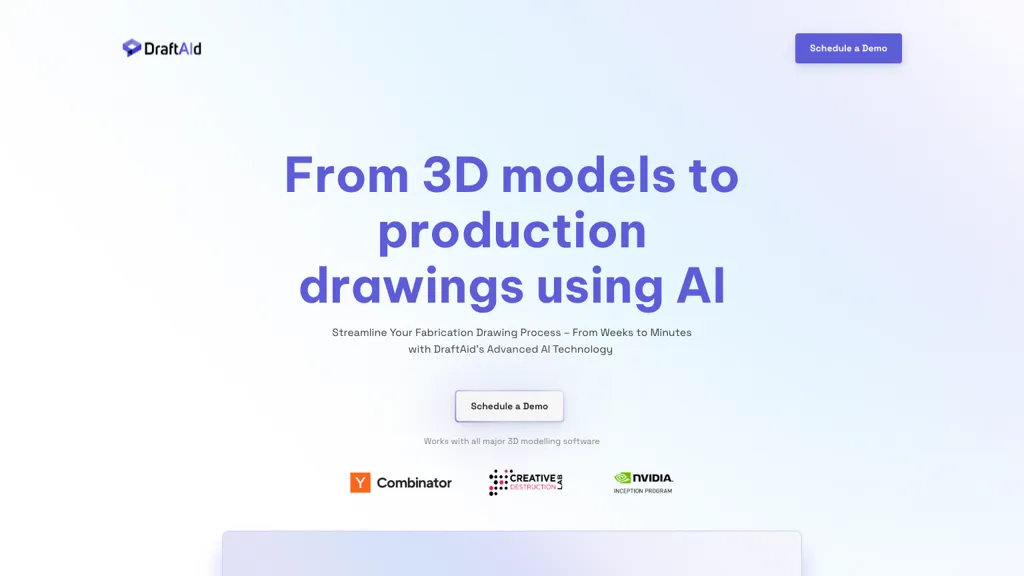What is DraftAid?
DraftAid is an advanced, AI-driven tool for managing and simplifying fabrication drawing. It automates the creation of detailed 2D fabrication drawings, which otherwise would take several weeks, in only a few minutes. The main goal of DraftAid is to save designers from boring tasks requiring numerous repetitions that are destined to be full of lots of errors.
Since it integrates smoothly with the major 3D modeling software, DraftAid provides a way of ensuring that the drawings are accurate and consistent in preventing manufacturing delays caused by human errors. It has options for customization according to particular project needs; hence, it makes it even faster and more effective.
DraftAid Key Features & Benefits
Automation of 2D fabrication drawings creation – one of the most time- and labor-consuming phases.
Smoothes integration with major 3D modeling software for maximum compatibility and ease of use. Provides options to customize the setting to meet particular project requirements, thus increasing the realm of flexibility. Improves design throughput with a simple three-step process: integrate, one-click automate, and review finalize. It saves designers from tedious and error-prone tasks and enables them to focus on higher-level tasks.
These features put together make DraftAid an attractive option for professionals who seek to optimize their design workflows and enhance their precision in fabrication drawings.
Use Cases and Applications of DraftAid
DraftAid can be used in a wide range of applications. Some of the use cases of the add-in are as follows:
-
Mechanical Engineers:
Leverage the power of DraftAid to create detailed 2D drawings of mechanical components with a high degree of accuracy, leaving little room for errors. -
Product Designers:
Automate fabrication drawings to free up productive time for creative designing and further development. -
Architects:
Accurately create 2D drawings in minimum time in architectural projects, ensuring smooth work on projects. -
Civil Engineers:
As projects involve the use of 3D modeling software, integrating DraftAid in your system is a way to produce accurate fabrication drawings in civil engineering projects. Reduce delays and minimize errors.
How to Use DraftAid
Using DraftAid is fairly simple and can be done in three easy steps:
-
Integration:
Integrate DraftAid into your favorite 3D modeling software. -
One-Click Automation:
One-click automation to get all the detailed 2D fabrication drawings. -
Review Finalization:
Review and finalize the drawings if they are meeting the project requirements.
Just remember one thing: for the best results, make sure that your 3D models are correct and complete before drafting them using this software. Also, don’t forget to keep updating this software to take full advantage of the latest features and improvements.
DraftAid Functionality
DraftAid uses some fairly advanced AI algorithms to help automate the fabrication drawing process. Here’s how it works:
The tool is integrated with major 3D modeling software, pulling geometric data from models. Further, AI-driven algorithms convert that data into very detailed 2D drawings, putting an emphasis on precision and consistency. Three main steps to the workflow are: integrating 3D software, generating the drawings in one click, and reviewing them for finalized output.
Pros and Cons of DraftAid
As goes with any tool, a few pros and cons come associated with its usage:
Pros:
- Dramatically reduces the time to create 2D fabrication drawings.
- Seamlessly fits with existing 3D modeling software.
- To suit a particular project, it may be tailored accordingly.
- Human errors are eliminated for more accurate and uniform drawings.
Possible Downsides:
- Initial setup and integration may require technical expertise.
- Out-of-the-box support with all 3D modeling software may not be available.
Generally, customer feedback covers saving time, improvement in accuracy, but at times, a few customers address the need for support for more software platforms.
Conclusion about DraftAid
DraftAid is indeed a powerful tool in automating the fabrication drawing process. The massive reduction in time and effort to create detailed 2D drawings, with its ease of integration with all major 3D modeling software, will make it a very valuable asset to designers of varied walks of life.
Apart from some minor inconveniences in initial set-up, its overall benefits significantly balance the cons of using DraftAid. In the future, updates will further increase its compatibility and make the features of this tool even stronger and well-established among the leading design automation tools.
DraftAid FAQs
-
What software does DraftAid integrate with?
DraftAid works well with major 3D modeling software to ensure a seamless workflow for designers. -
Can I get DraftAid customized for any specific projects?
Yes, DraftAid has options for customizing specific project needs. -
How does DraftAid enhance accuracy?
By automating the process of drawing, DraftAid eliminates the possibility of human error; hence, the output is accurate and constant. -
What kind of support is available for new users?
DraftAid has full support, from guides through setup to tutorials and customer service, that will help ease a new user into the service. -
Is there a trial?
This has the added advantage of a trial version where many users can be taken on board to explore DraftAid’s features before finally committing users to a subscription plan.










